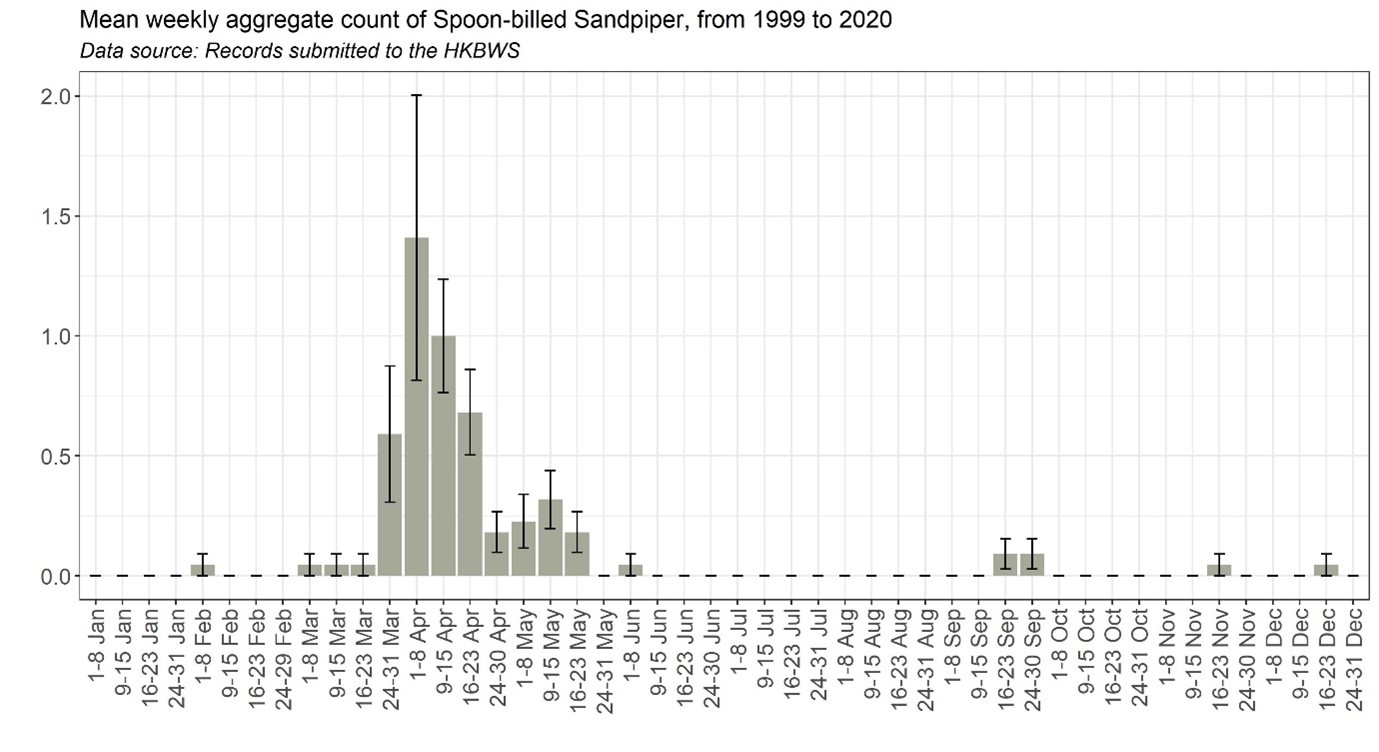SPOON-BILLED SANDPIPER Calidris pygmaea 勺嘴鷸
Category I. Scarce passage migrant in spring, rare in autumn and winter; occurs on intertidal mudflats of Deep Bay and adjacent roost sites.
IDENTIFICATION

May 2017, Michelle and Peter Wong.
14-16 cm. When seen well the highly distinctive spoon-shaped bill is diagnostic; however, beware Red-necked Stints that have mud on the end of the bill. Most birds seen in spring in HK are largely in non-breeding plumage and appear grey-brown above with white underparts extending to fore part of face and forehead. The varying amount of breeding plumage is usually most obvious on the scapulars. Birds in more advanced breeding plumage have dark centres to the scapulars and mantle feathers, orange-brown colouration on the face and chest and streaks on the chest.
Juveniles have dark-centred upperpart feathers with broad whitish to buff fringes, a buff-tinged chest with dark streaks at the sides, dark warm brown central crown area, white forehead and a dark line through the lores.
VOCALISATIONS
Van Gils et al. (2020) refer to a shrill, ascending ‘whoeat…whoeatt’ in winter and a short ‘puree’, ‘preep’ or shrill ‘wheet’ in flight.
DISTRIBUTION & HABITAT PREFERENCE
All records are from the Deep Bay area where birds forage mainly on the intertidal mudflats and roost inland at high tide, primarily at Mai Po NR, though occasionally on drained fish ponds. During spring they generally associate with Red-necked Stints, whereas the very few winter records have involved a single bird in the wintering flock of Dunlin and Kentish Plover.
OCCURRENCE
Spoon-billed Sandpiper, the most charismatic wader on the HK List, is generally recorded on spring passage though there are a handful of records during autumn and winter (Figure 1).
The earliest spring record appears to be a bird that was present during 8-23 March 2012, as there were no records the winter immediately prior. Main spring passage occurs during the first three weeks of April and has been recorded until 8 June. The highest count is of 13 birds on 3 April 2005 though in general no more than three birds are recorded in a day. Based on plumage characteristics of birds observed, the number of individuals was calculated to be 16 during spring 1990 and 12 in 1998. In addition, Herklots (1967) reported a record of about 12 on 23 April 1961; however, there is no documentation of this in HKBWS files.
In contrast, there are very few records in the second half of the year. A total of six autumn records have occurred from 6 August to 25 October. Single presumed wintering birds have been noted from 11 November to 5 February in seven winter periods, though in only two this century.
Spoon-billed Sandpiper appears to have decreased this century, which would not be surprising given that it is listed as Critically Endangered by BirdLife International (2023). In the period from 1999 to 2020 there were four years in which there were only one or two spring records, while in 2002 there were none. The previous year in which no birds were recorded on spring passage was 1983, a time when there was very limited access to the intertidal mudflats and Mai Po Nature Reserve, with its high tide roost area, was not yet established.
The first record of Spoon-billed Sandpiper in Hong Kong is that of Walker (1958), who had two at Mai Po on 11 May 1957. Macfarlane and Macdonald (1966) stated that up to 1963 there were eleven records, all in Deep Bay, involving one to three birds between 17 April and 30 May and 29 September to 6 October.
BEHAVIOUR, FORAGING & DIET
Cha and Young (1991) described food items of this species based on one faecal sample; these were polychaete worms and micro gastropods. Forages and roosts with other small waders.
RANGE & SYSTEMATICS
Monotypic. Breeds near the coast of the Chukotsky peninsula south to north Kamchatka, and winters coastally from south China through Indochina to Bangladesh south to Sri Lanka, Singapore and Philippines (Van Gils et al. 2020). In China a migrant along the east and south coasts, including Taiwan, and a winter visitor to the south coast including Hainan (Liu and Chen 2020).
CONSERVATION STATUS
IUCN: CRITICALLY ENDANGERED. Population decreasing by an estimated 8% annual reduction due to habitat loss in its breeding, passage and wintering grounds, disturbance, pollution, climate change and, in particular, the effects of indiscriminate shorebird hunting.
Figure 1.

BirdLife International (2023) Species factsheet: Calidris pygmaea. Downloaded from http://datazone.birdlife.org/species/factsheet/spoon-billed-sandpiper-calidris-pygmaea on 20/05/2023.
Cha, M. W. and L. Young (1991). Food of the Spoon-billed Sandpiper in Hong Kong. Hong Kong Bird Report 1990: 192-193.
Herklots, G. A. C. (1967). Hong Kong Birds (2nd ed.). South China Morning Post, Hong Kong.
Liu, Y. and Y. H. Chen (eds) (2020). The CNG Field Guide to the Birds of China (in Chinese). Hunan Science and Technology Publication House, Changsha.
Macfarlane, A. M. and A. D. Macdonald, revised by Caunter, J. R. L. and A. M. Macfarlane (1966). An Annotated Check-list of the Birds of Hong Kong. Hong Kong Bird Watching Society, Hong Kong.
Van Gils, J., P. Wiersma, C. J. Sharpe, and G. M. Kirwan (2020). Spoon-billed Sandpiper (Calidris pygmaea), version 1.0. In Birds of the World (J. del Hoyo, A. Elliott, J. Sargatal, D. A. Christie, and E. de Juana, Editors). Cornell Lab of Ornithology, Ithaca, NY, USA. https://doi.org/10.2173/bow.spbsan1.01
Walker, F. J. (1958). Field observations on birds in the Colony of Hong Kong. Hong Kong Bird Watching Society, Hong Kong (duplicated).

